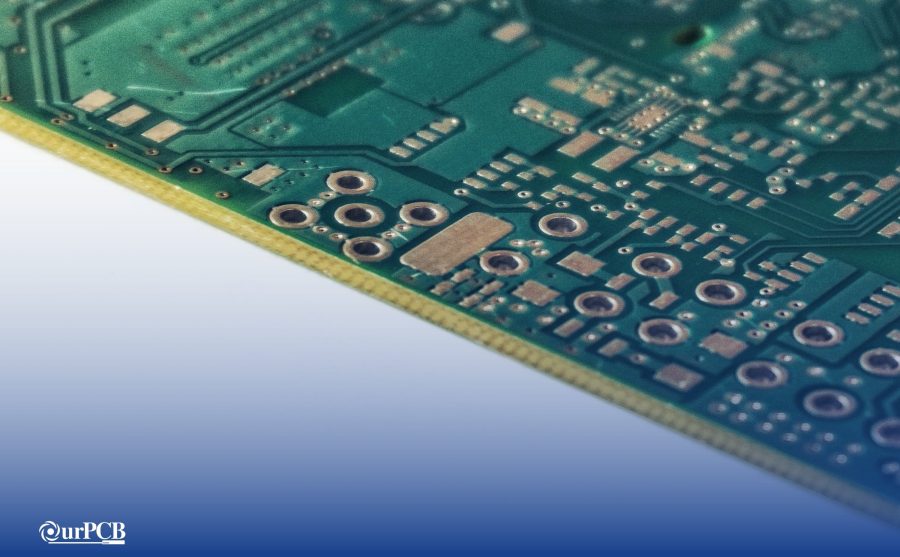Breadboard simulators have completely changed the way we design and test electronic circuits. They are not just fun circuit simulation software for hobbyists, they are also an excellent educational tool and a valuable asset in professional PCB design (Printed Circuit Boards) and prototyping.
Whether you're just starting out in electronics or need a quick way to test and refine your circuit designs, the professionals at OurPCB suggest trying out a quality breadboard simulator. You may find yourself diving deep into these simulation tools, spending hours experimenting and picking up new skills!
Read on to learn all you need about breadboard simulators and get started using one for practice, learning, or simply for the fun of it.
Contents
- Key Takeaways
- What is a Breadboard Simulator?
- Popular Breadboard Simulators
- 123D Circuits (Tinkercad)
- Fritzing
- EasyEDA
- EveryCircuit
- Online Breadboard Simulator
- Why use a Breadboard Simulator?
- Cost-Effective Learning and Testing
- Accessibility
- Safe Experimentation
- Improve PCB Design and Efficiency
- How does a Breadboard Simulator Work?
- 1. Design Your Circuit
- 2. Drag-and-Drop Interface
- 3. Circuit Connections
- 4. Simulation and Testing
- 5. Debugging Tools
- 6. Educational Features
- 7. Saving and Sharing Designs
- Key Features of a Good Electronic Breadboard Simulator
- Interactive Component Libraries
- Simulation Capabilities
- Educational Tools
- Wide Compatibility Range
- Support for Different Circuits
- Getting Started with a Breadboard Simulator
- 1. Account Creation and Setup
- 2. Select a Project
- 3. Design a Circuit
- 4. Simulate the Circuit
- Advanced Features and Techniques
- Using Microcontrollers
- PCB Design and Export
- Collaborative Features
- OurPCB: Comprehensive PCB Assembly Services
- Best Breadboard Simulators for Efficient Circuit Prototyping FAQs
- Can I use a Breadboard Circuit Simulator for Professional Circuit Design?
- How Accurate are Breadboard Simulators Compared to Real-World Circuits?
- What are the Limitations of Using Breadboard Simulators for PCB Design?
- Is it Possible to use Breadboard Simulators Offline?
Key Takeaways
- Breadboard simulators enable virtual circuit design and testing, useful for all skill levels.
- Tinkercad, Fritzing, EasyEDA, and EveryCircuit are popular, feature-rich simulators.
- Simulators offer cost-effective and safe circuit experimentation.
- Advanced features like SPICE analysis help identify errors early in design.
- Breadboard simulators streamline PCB prototyping, saving time and resources.
What is a Breadboard Simulator?
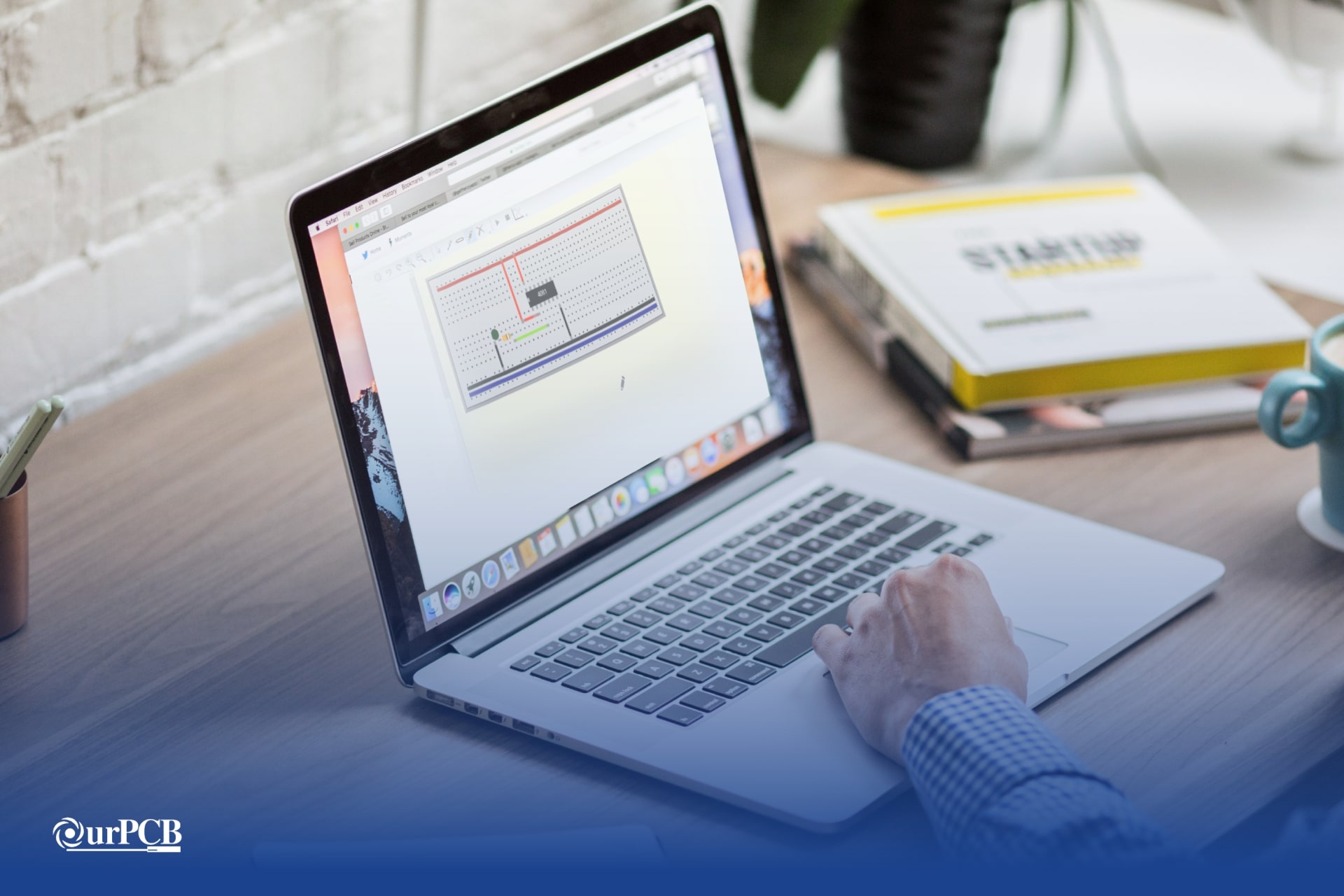
A breadboard simulator is a digital tool that allows you to design and test electronic circuits virtually before building them in the real world. It mimics the functionality of a physical breadboard, giving you an online platform to place virtual components like resistors, capacitors, and integrated circuits.
Top simulators often include interactive features that let you visualize electricity flow and catch errors instantly. These tools aren’t just for experimenting or playing around; they’re essential in education, prototyping, and hobbyist electronics, making circuit design and testing easier.
Many users rely on programs and use LTSpice, a popular SPICE simulator, to analyze circuits and design the electronic circuit efficiently, whether working on a wide breadboard or testing transistor setups in various circuit simulation programs.
Popular Breadboard Simulators
Now that you know what goes into that powerful breadboard simulator software, let's talk about the most popular software and circuit simulation tools out there! Here are the best breadboard simulators you can use:
123D Circuits (Tinkercad)
123D Circuits, now integrated into Tinkercad, is a popular online simulator that allows users to design and simulate circuits on a breadboard. This breadboarding software has a user-friendly interface suitable for beginners and advanced users alike.
You can create schematics, design PCBs, and test your circuits in real time. Tinkercad provides a huge library of components, making it easy to prototype and test ideas without needing physical components.
Fritzing
Fritzing is an open-source hardware initiative that makes electronics accessible to everyone. It offers a breadboard view, schematic view, and PCB view, allowing you to design and document your circuits.
Fritzing is a breadboard software that also provides a large library of components and a community-driven platform where users can share and download projects. It’s an excellent tool for educators, hobbyists, and anyone interested in learning about electronics.
EasyEDA
EasyEDA is a web-based EDA (Electronic Design Automation) tool suite that includes schematic capture, PCB layout, and simulation capabilities. It supports SPICE simulation, enabling you to test and analyze circuits before manufacturing. The platform also offers a large library of components and integrates with PCB manufacturing services.
EveryCircuit
EveryCircuit is an online circuit simulator that provides an interactive and visual approach to learning and designing circuits. It features a real-time simulation engine, allowing you to see how circuits behave as you build them.
EveryCircuit is available on both web and mobile platforms, so it’s accessible for learning and prototyping on the go. It’s particularly useful for students and educators due to its intuitive interface and educational resources.
Online Breadboard Simulator
Online Breadboard Simulator is a free, browser-based tool. It has a simple and straightforward interface, making it easy for beginners to get started with electronics. One of the most fun things about this simulator is that you can earn digital badges for completing circuits.
Why use a Breadboard Simulator?
Breadboard simulators have several benefits that result in saving you time and money!
Cost-Effective Learning and Testing
Breadboard simulators are a budget-friendly way to learn and test electronic circuits. Traditional breadboarding (in the physical world) means you need to buy various components, which can be costly, especially for beginners who are likely to make mistakes.
Using a breadboard online simulator, you can experiment with a wide range of components without any additional costs. This allows learners and hobbyists to fearlessly try out different designs and understand circuit behavior without wasting money.
Accessibility
Many excellent simulators are available for free or at a low cost, so they are easily accessible to people in any financial situation. These online simulators are widely available some of the best free circuit simulators can be used on many different devices, like computers and tablets. This makes them convenient for both classroom and home use.
Safe Experimentation
Using a breadboard simulator is the safest way to learn! There’s no risk of damaging equipment and parts or injuring yourself while you’re experimenting. Simulators also reduce electronic waste, which contributes to a more sustainable approach to electronics learning and experimentation.
Moreover, working with real electronic components brings with it the risk of short circuits, overheating, or electrical shocks. Simulators give you a safe environment to experiment with different circuit configurations and learn from mistakes without any real-world consequences. This is handy for beginners who are still learning the basics of electronics. It’s the perfect way to build confidence and skills before moving on to physical components.
Improve PCB Design and Efficiency
Breadboard simulators also allow designers to prototype their circuits and test their functionality before committing to a real PCB layout. Designers can iterate quickly and improve their designs without tedious assembly and disassembly. This step is also essential for error detection and resolving issues that could be expensive and time-consuming to fix after manufacturing.
By using a simulator, designers can test complex circuits, which is particularly useful for advanced projects and for those looking to push the boundaries of their designs. Additionally, designers can check that their circuits work as intended, optimize component placement, and refine their designs. This results in higher-quality PCBs with fewer errors, saving both time and resources in the development process.
Special Offer: Get $100 off your order!
Email [email protected] to get started!
How does a Breadboard Simulator Work?
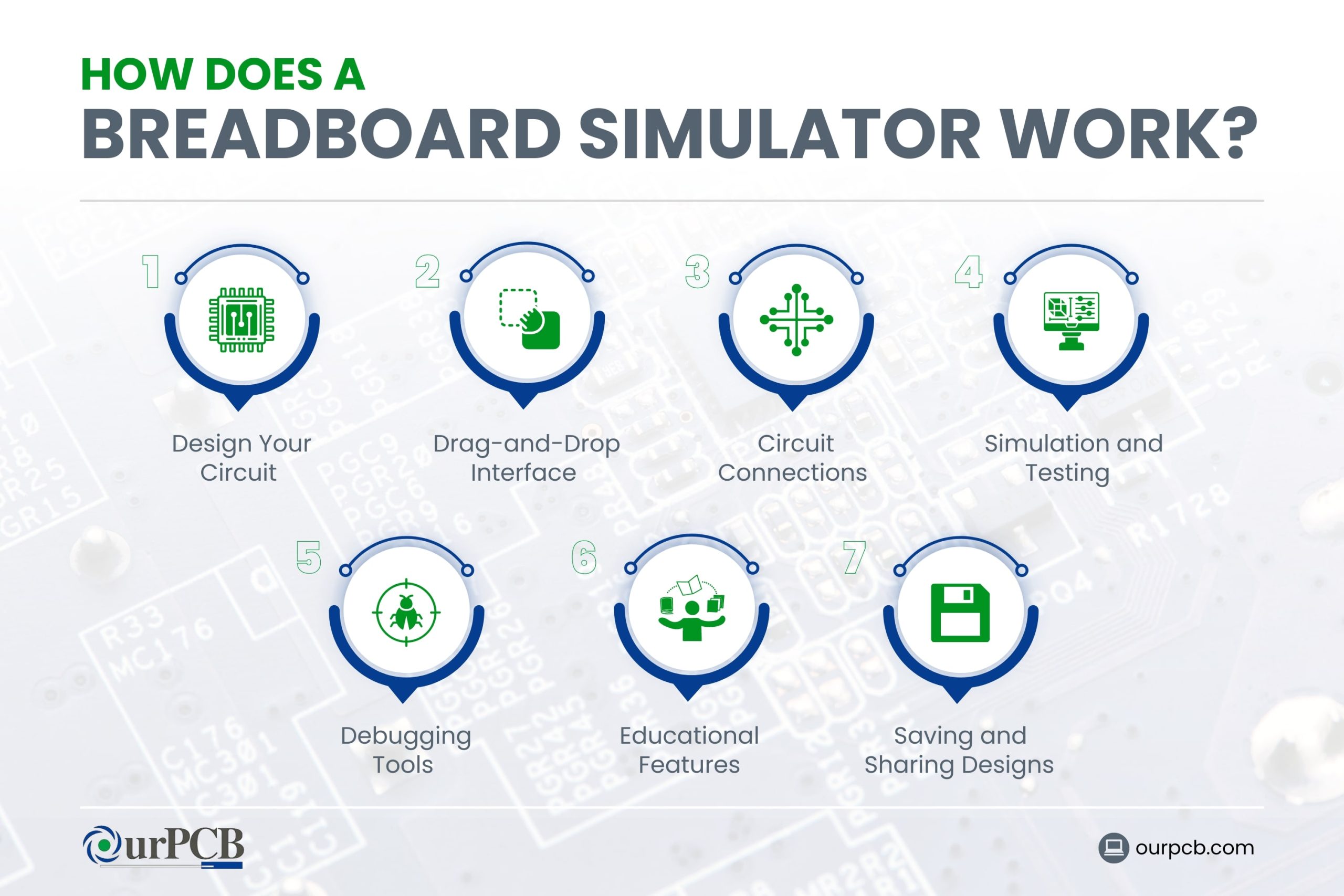
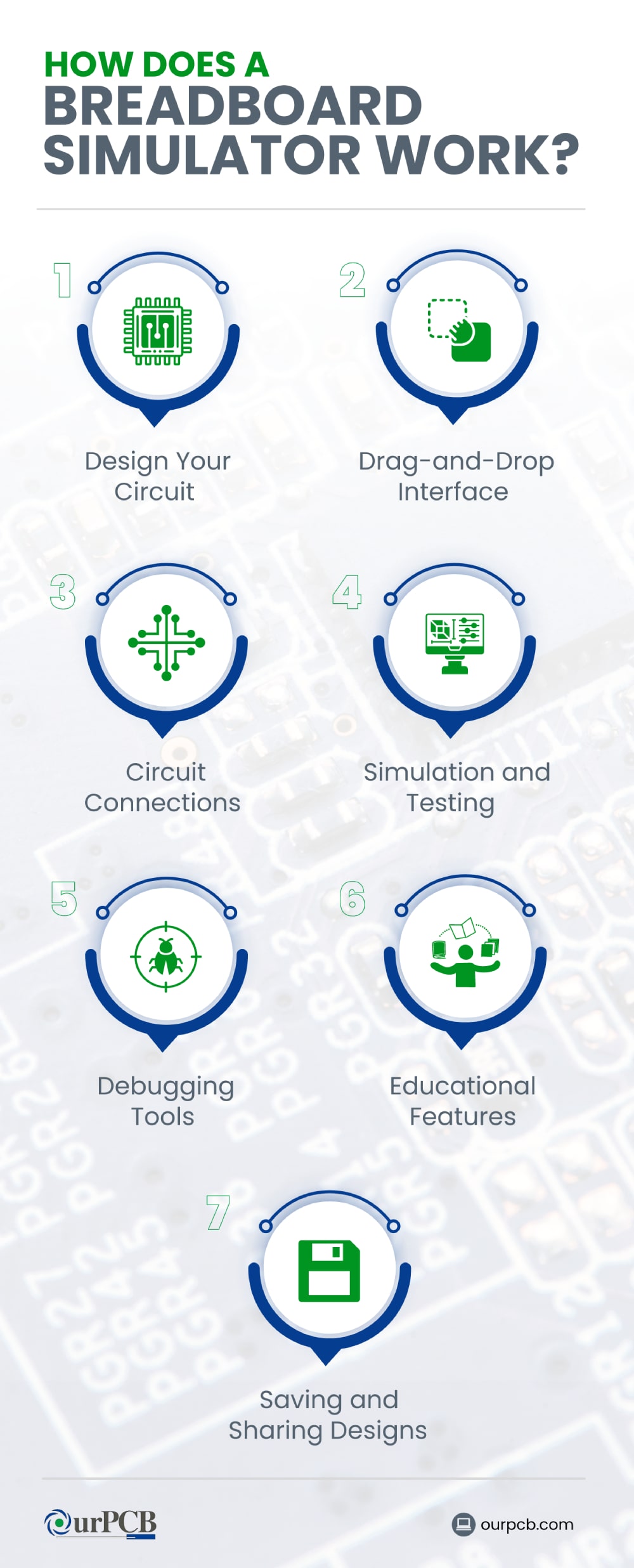
When using the best simulator for breadboarding, you can design and simulate breadboard circuits with ease. A breadboard simulator allows you to perform detailed circuit analysis, giving you accurate simulation results that mimic a real circuit. By running a SPICE circuit simulation, you can test your design to make sure it functions as expected before building the actual circuit, helping avoid errors and streamline the process. Here's how the simulator works!
1. Design Your Circuit
Breadboard simulators give you a virtual representation of a breadboard, and you choose and place a range of electronic components like resistors, capacitors, LEDs, and integrated circuits.
2. Drag-and-Drop Interface
The user interface is simple, often allowing you to drag and drop components onto the breadboard. This mimics the experience of working with a physical breadboard, but it comes with the added convenience of easily changing components and connections.
3. Circuit Connections
You’ll connect components by drawing wires between them. The simulator makes the connections look realistic, following the rules of electronics. It also allows for easy reconfiguration, which isn’t always possible with a physical breadboard.
4. Simulation and Testing
Once the circuit is built, the simulator can run the circuit to test its functionality. It uses mathematical models and algorithms to simulate how electricity flows through the circuit, giving you real-time feedback on performance. You can observe the behavior of the circuit on the circuit simulation, like voltage and current at different points.
5. Debugging Tools
Many simulators come with debugging tools that highlight errors or potential issues in the circuit. This can include short circuits, open circuits, or incorrect component values. These tools help you learn and correct mistakes before building the actual physical circuit.
6. Educational Features
Breadboard simulators often include educational features like step-by-step tutorials, interactive lessons, and detailed explanations of components and circuit theory. Because of this, a breadboard circuit is a great tool for hobbyists, amateurs, and students interested in learning about electronics.
7. Saving and Sharing Designs
You can save your circuit designs and easily share them with others. This is useful for collaborative projects or if you’re seeking advice from more experienced electronics enthusiasts.
Key Features of a Good Electronic Breadboard Simulator
A good electronic breadboard simulator offers essential features that simplify circuit design and testing. With tools to create circuit schematics and run accurate simulation to make sure your setup works, these simulators are invaluable for both beginners and experts.
Many include options from Linear Technology and come as open-source software, allowing users to access and modify the source code. Pretty neat, right? These features make prototyping faster and more reliable. Here are some key features:
| Feature | Description |
|---|---|
| Component Library | Drag-and-drop access to components with detailed specs and search options. |
| Simulation | Real-time analog and digital circuit simulation, plus advanced analysis features. |
| Educational Tools | Includes tutorials, quizzes, and progress tracking for electronics learning. |
| Compatibility | Runs on various OS and devices; supports SPICE and Gerber file import/export. |
| Circuit Support | Supports DC, AC, and mixed-signal circuits with schematic and PCB layout options. |
Interactive Component Libraries
You’ll find a wide range of electronic components in an easy-access library, including resistors, capacitors, diodes, and integrated circuits. You can easily drag and drop components onto the virtual breadboard to create and visualize circuits quickly.
An effective simulator will have searchable libraries and detailed specifications for each component, making it easier for you to find what you need and understand the components’ roles in your circuits.
Simulation Capabilities
Virtual breadboard simulators have robust simulation capabilities to accurately replicate real-world circuit behavior. In the best circuit simulation, this should include the ability to simulate both analog circuits and digital circuits.
You should be able to run your circuits in real time, observe voltage and current changes, and identify potential issues before physical prototyping. Advanced simulators also offer more complex features like transient analysis, frequency response, and noise simulation.
Educational Tools
Educational tools are a huge benefit of breadboard simulators, especially for students and beginners. They often include tutorials, guided experiments, and interactive lessons that teach the fundamental concepts of electronics.
Simulators with built-in quizzes and progress tracking can help you test your knowledge and monitor your learning progress. These aspects make learning electronics more accessible and engaging.
Wide Compatibility Range
Effective breadboard simulators are compatible with numerous operating systems and devices. They should run smoothly on Windows, macOS, and Linux, and have mobile versions for Android and iOS.
Good breadboard simulators are also compatible with different file formats, for e.g, SPICE and Gerber files, allowing you to import and export your designs easily. This flexibility means you can work on your projects from multiple devices and share your designs with others seamlessly.
Support for Different Circuits
A good breadboard simulator provides support for multiple types of circuits, including simple DC circuits, AC circuits, and complex mixed-signal circuits. It should also accommodate different circuit design methodologies, like schematic capture and PCB layout.
You should be able to experiment with different configurations and components, for a wide range of projects, from basic educational circuits to advanced professional designs.
Getting Started with a Breadboard Simulator
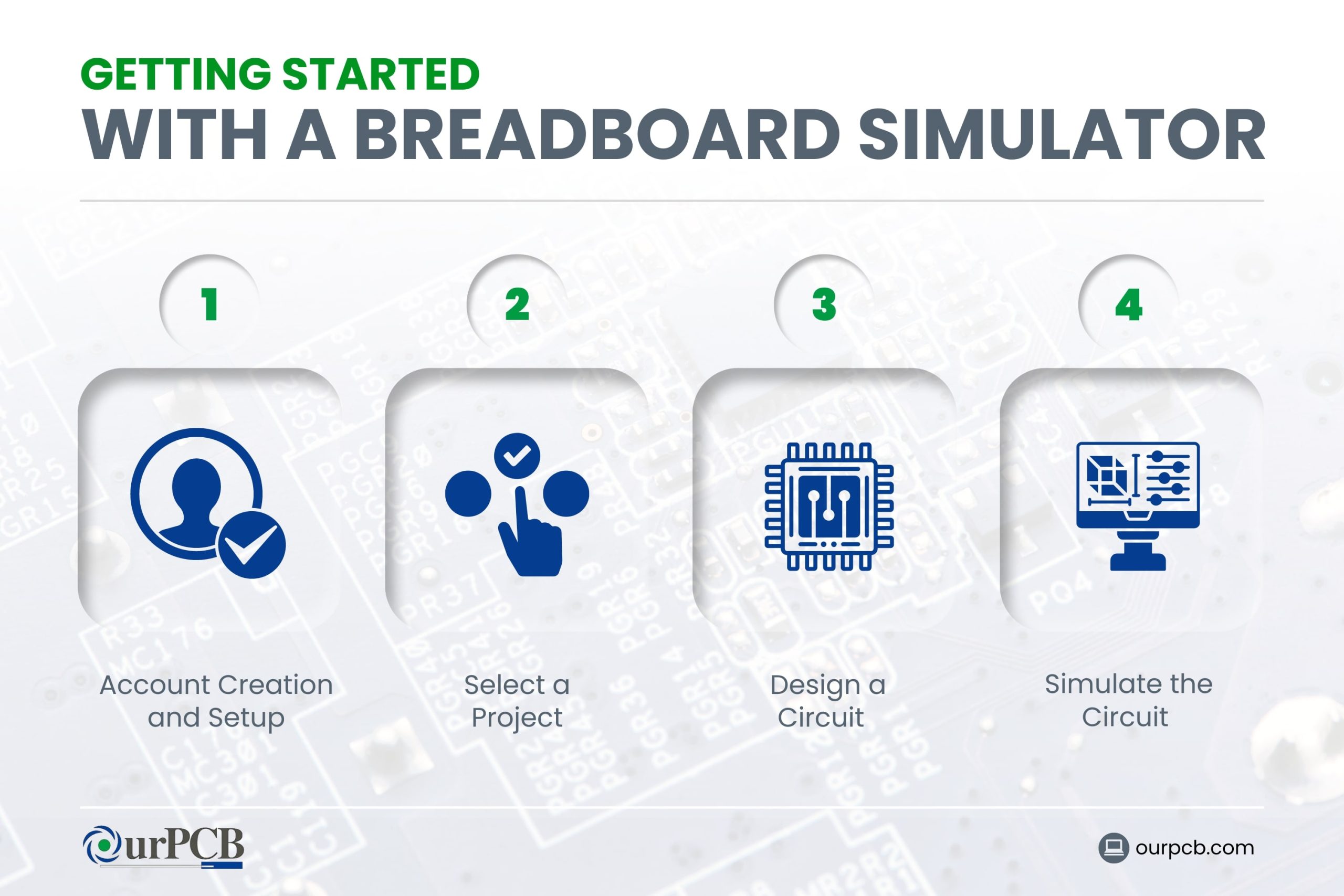
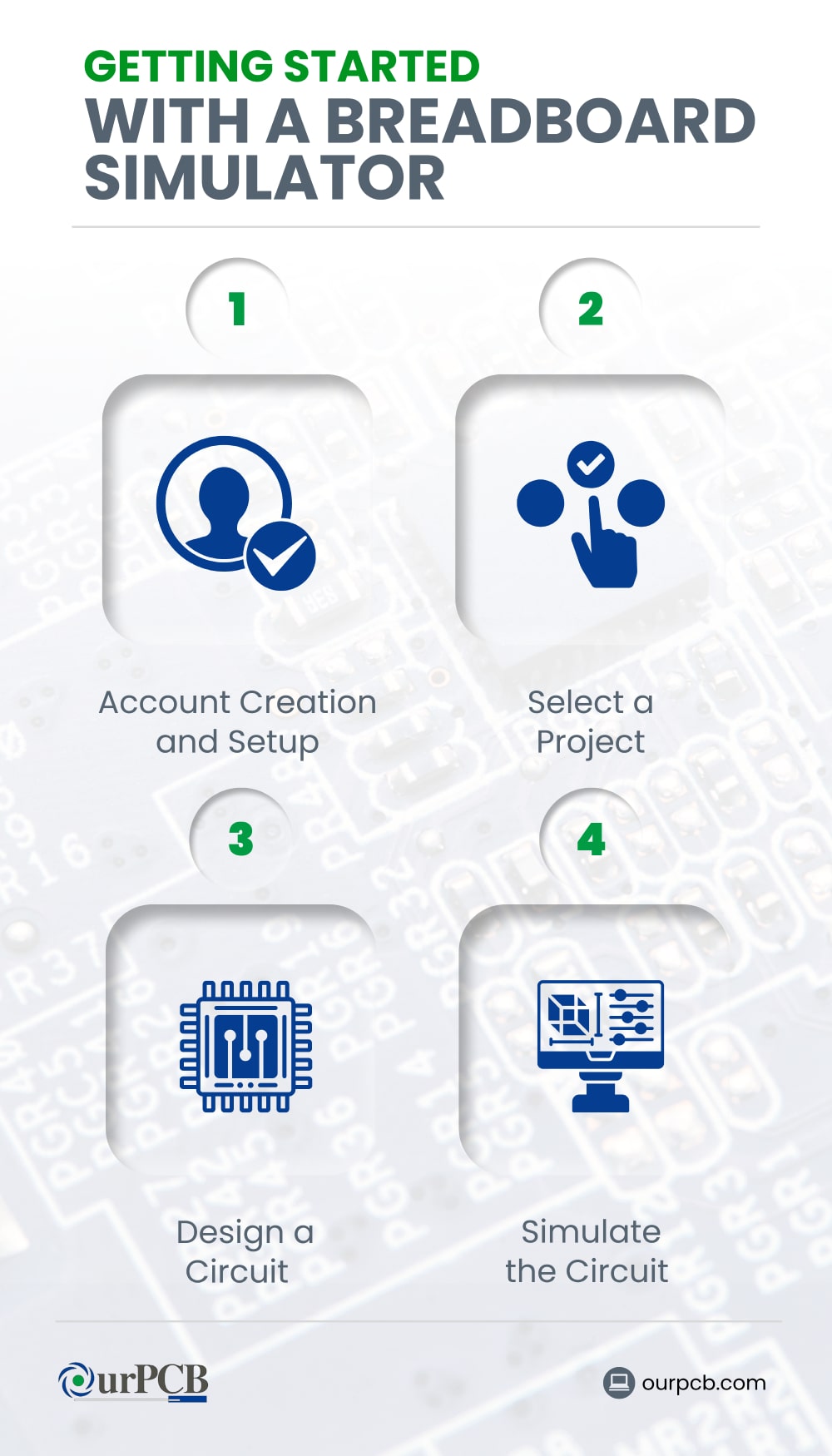
Starting with a breadboard simulator is simple and opens up endless possibilities for experimenting with circuit designs. Follow these steps to set up, design, and test your first circuit!
1. Account Creation and Setup
Before you start using a breadboard simulator, you’ll need to create an account on the platform of your choice. Go to the website and click on the “Sign Up” or “Register” button. You will likely need to provide an email address, create a username, and set a password.
Check your email for a verification link from the platform. Fill in your details and then decide which plan suits your budget. Many breadboard simulators have excellent free plans. Once your account is set up, you’re ready to explore the features.
2. Select a Project
Start with a project that matches your current understanding of electronics. Beginners might choose simple LED circuits, while more advanced users could opt for projects involving microcontrollers or sensors.
You can also select a project based on what you want to learn. If you’re interested in basic circuit design, start with simple resistor and capacitor circuits. If you’re aiming to understand more complex concepts, pick projects involving integrated circuits or communication modules.
3. Design a Circuit
Use the simulator’s library to select the components you need for your project. This can include resistors, capacitors, LEDs, switches, microcontrollers, and more. Drag and drop the components onto the virtual breadboard and arrange them in a way that mimics how you would set up a physical breadboard.
Use virtual wires to connect the components according to your circuit diagram. Make sure to connect power and ground correctly to avoid errors. Use color-coded wires to keep track of different connections. Many simulators allow you to add labels or notes to your circuit, which can help you remember the purpose of each component and connection.
4. Simulate the Circuit
Once your circuit design is complete, it’s time to simulate it. Click on the “Start Simulation” or equivalent button. This will initiate the simulation process, which is where the fun starts!
Watch how your circuit behaves in the simulation. Check if the LEDs light up as expected, if sensors give the correct readings, or if the microcontroller is performing the desired tasks.
If the circuit doesn’t work as expected, use the simulator’s debugging tools to identify issues. Common problems include incorrect connections, wrong component values, or logical errors in the design.
Modify your circuit based on the issues identified. This might involve rearranging components, changing values, or correcting connections. After making adjustments, run the simulation again to see if the issues are fixed. Repeat until your circuit works.
Advanced Features and Techniques
Want to take things a step further? Here are the top advanced features and techniques for breadboard simulators!
Using Microcontrollers
Microcontrollers are tiny computers on a single chip, designed to perform specific tasks. Popular microcontrollers include Arduino, Raspberry Pi, and ESP32. When choosing a microcontroller, consider the project’s requirements, like processing power, connectivity, and ease of use.
PCB Design and Export
PCB design involves creating a schematic, laying out the components, and designing the traces that connect them. Software tools like Eagle, KiCad, and Altium Designer are popular for PCB design.
- Create a schematic
- Component placement
- Routing
- Design rules check (DRC)
- Export Gerber files
Collaborative Features
Many breadboard tools have built-in collaboration tools, which means you can share your circuits with other people. This can be handy if you’re learning with a friend, taking part in a class, or using the virtual breadboard for work.
OurPCB: Comprehensive PCB Assembly Services
Breadboard simulators are changing the circuit design game, allowing both beginners and professionals to test and refine circuits with ease. At OurPCB, we understand the value of efficient prototyping, which is why we offer top-tier PCB assembly services to bring your final designs to life.
By using a breadboard simulator, you can perfect your designs before committing to physical PCB production, saving valuable time and resources. Ready to take your project to the next level? Contact OurPCB today for reliable and comprehensive PCB assembly support.
Best Breadboard Simulators for Efficient Circuit Prototyping FAQs
Can I use a Breadboard Circuit Simulator for Professional Circuit Design?
Yes, many breadboard simulators offer advanced features for professional circuit design. These include accurate simulation capabilities, support for complex circuits, and the ability to export designs for PCB manufacturing.
How Accurate are Breadboard Simulators Compared to Real-World Circuits?
While breadboard simulators strive to replicate real-world circuit behavior accurately, there can be some discrepancies, especially in high-frequency or complex analog circuits. However, they are generally reliable for most educational and prototyping purposes.
What are the Limitations of Using Breadboard Simulators for PCB Design?
While breadboard simulators are great for prototyping and initial testing, they might not account for all practical issues like component placement, wire lengths, and real-world interference. Specialized software like Autodesk Eagle or KiCad is recommended for detailed PCB design.
Is it Possible to use Breadboard Simulators Offline?
Some breadboard simulators offer offline versions or desktop applications that don’t require an internet connection. However, many are web-based and need an internet connection to access their full range of features.
Back to Top: Best Breadboard Simulators for Efficient Circuit Prototyping
Special Offer: Get $100 off your order!
Email [email protected] to get started!







